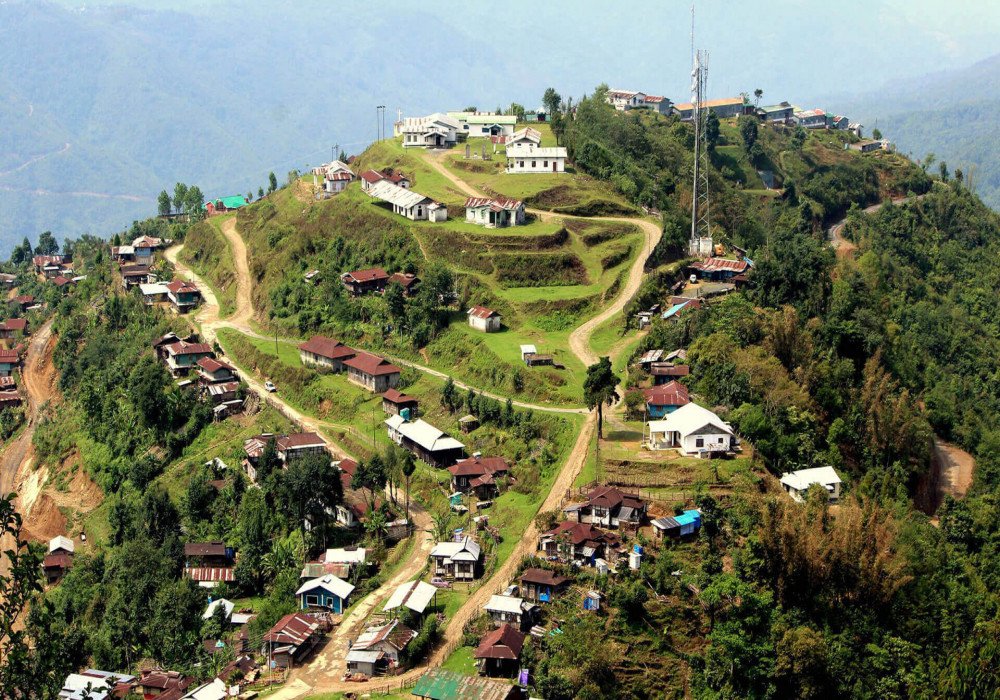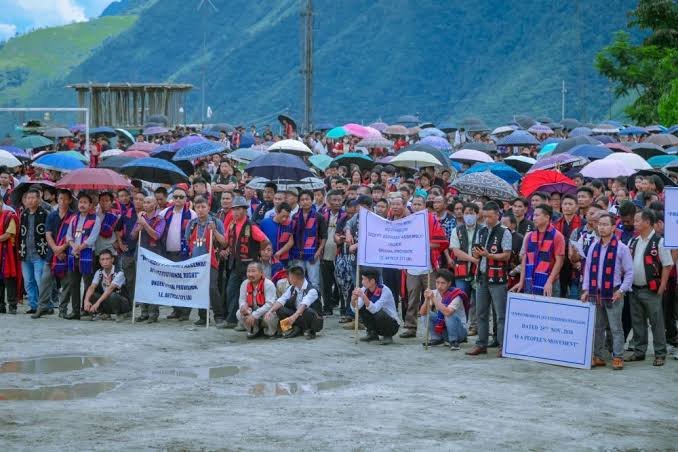By: Dipak Kurmi
The Mizoram Assembly, on August 22, unanimously passed a resolution opposing the Forest (Conservation) Amendment Act, 2023, aimed at safeguarding the rights and interests of Mizoram’s people. This amendment permits the use of forest land for infrastructure projects near India’s international borders without the need for forest clearance, impacting most of India’s Northeast. Next week, the Nagaland Assembly will face similar pressure to denounce the Amendment, while Tripura, Mizoram, and Sikkim, governed by the BJP or its allies have already voiced their opposition to the 100km exemption clause.
The application of the Forest (Conservation) Act (FCA) in the Northeast region is contingent upon special constitutional safeguards, like Article 371A for Nagaland and 371G for Mizoram. These provisions prevent the imposition of any Parliament-enacted law that interferes with Naga and Mizo customary practices, land ownership, and resource transfer. Such legislation can only be extended to these states if their Legislative Assemblies pass a resolution in favor of it.
In 1986, Nagaland extended the Forest (Conservation) Act (FCA) to cover “government forests and such other forests and Wildlife Sanctuaries under the control of the State Government,” even though government forests constituted just 2.71% of the state’s Recorded Forest Area. However, in December 1997, the Home Ministry, in consultation with the Ministry of Law and Justice, affirmed to the Union Environment Ministry that the FCA did not apply to Nagaland since its Legislative Assembly hadn’t passed a resolution for its application. This stance was later contradicted in November 1998 when the Environment Ministry informed Nagaland that the FCA did apply, following clarification from the Ministry of Law and Justice. Despite these developments, the Environment Ministry has not granted FCA clearance to forests in Nagaland since 1980.
Unlike Nagaland, Mizoram’s legal framework differs. In 1986, it transitioned from a Union Territory to a State through the 53rd constitutional amendment, which introduced Article 371G. This amendment extended all Central Acts, including the Forest (Conservation) Act (FCA), to the state. Furthermore, the authority of Autonomous District Councils in Mizoram’s Sixth Scheduled areas doesn’t encompass reserved forests. Consequently, the FCA applies to 84.53% of non-notified forest areas in Mizoram, with 6,630 hectares having obtained FCA clearance to date.
The Forest (Conservation) Act (FCA) is applicable in the remaining Northeastern states, including Meghalaya and Tripura, along with their Sixth Schedule Areas, as well as Arunachal Pradesh, Sikkim, and Manipur. Among these states, Arunachal Pradesh leads in FCA clearances with 21,786.45 hectares, followed by Tripura (9,051 ha), Assam (5,261 ha), Manipur (3,604 ha), Sikkim (2,902 ha), and Meghalaya (807 ha).
The term “RFA” refers to Recorded Forest Area, and since 1980, over a million hectares of forest have been diverted across India under the Forest (Conservation) Act (FCA). The FCA is aimed at deforestation under the Indian Forest Act of 1927 and its State variations. In 1996, the Supreme Court’s Godavarman case broadened the definition of “forest land” under the FCA to include areas recorded as forest in government records, encompassing unclassed forests – those recorded as forests but not officially designated as such. In the Northeast, more than half of the region falls under the Recorded Forest Area, with 53% being unclassed forests governed by customary law and the remainder being notified forests under the control of State Forest Departments.
The Forest (Conservation) Act (FCA) applies to the entire Northeast region, including Meghalaya and Tripura, as well as their Sixth Schedule Areas. It also covers Arunachal Pradesh, Sikkim, and Manipur. Among these states, Arunachal Pradesh leads in FCA clearances with 21,786.45 hectares, followed by Tripura (9,051 ha), Assam (5,261 ha), Manipur (3,604 ha), Sikkim (2,902 ha), and Meghalaya (807 ha).
“RFA” refers to Recorded Forest Area, and since 1980, over a million hectares of forest have been diverted across India under the Forest (Conservation) Act (FCA), which seeks to deforest under the Indian Forest Act of 1927 or its State counterparts. In 1996, the Supreme Court, in the Godavarman case, broadened the definition of “forest land” in the FCA to include any area recorded as forest in government records, encompassing unclassed forests – those recorded as forests but not officially designated as such. In the Northeast, more than half of the region falls under Recorded Forest Area, with 53% being unclassed forests controlled by individuals, clans, village councils, or communities and governed by customary law and procedures, while the rest is notified forest under the control of State Forest Departments.
Recorded Forest Area (RFA) varies across Northeastern states, ranging from 34.21% in Assam to 82.31% in Sikkim, with Mizoram at 35.48%, Meghalaya at 42.34%, Nagaland at 53.01%, Arunachal Pradesh at 61.55%, Manipur at 78.01%, and Tripura at 60.02%. Among these, unclassed forests, which are not officially designated as forests, range from absent in Sikkim to 97.29% in Nagaland, with percentages of 15.47% in Mizoram, 33.43% in Assam, 42.96% in Tripura, 75.67% in Manipur, and 88.15% in Meghalaya.
In 1996, the Supreme Court’s ruling extended the Forest (Conservation) Act’s jurisdiction to unclassed forests nationwide. Furthermore, there exist forests beyond the Recorded Forest Area (RFA), which have neither been recorded nor surveyed, comprising 38.5% of Assam’s forests, 29% in Nagaland, and 1.5% in Mizoram.
The Scheduled Tribes and Other Traditional Forest Dwellers (Recognition of Forest Rights) Act (FRA) of 2006 defines “forest land” to encompass various types of forest areas, including unclassified forests, undemarcated forests, existing or deemed forests, protected forests, reserved forests, Sanctuaries, and National Parks. This definition aligns with the Supreme Court’s 1996 redefinition, providing recognition and rights to forest-dwelling communities.
The Scheduled Tribes and Other Traditional Forest Dwellers (Recognition of Forest Rights) Act (FRA) extends benefits to most Northeastern states, particularly those with substantial unclassified forests. The FRA also includes a provision allowing for the recognition of rights established under state laws, autonomous district councils, regional councils, or customary tribal laws. These states have the flexibility to proactively acknowledge these existing rights and seek Gram Sabha approvals to grant titles. Additionally, the Ministry of Tribal Affairs can issue legally binding directives under Section 12 of the FRA, providing an additional layer of legal protection for traditional community forest tenure rights.
Most Northeastern states, with the exception of Assam and Tripura, have not implemented the FRA. This is attributed to the perception that the FRA is irrelevant due to the predominant ownership of land by communities, clans, chiefs, and individuals, who already enjoy their rights, as well as the limited presence of forest-dwelling communities entirely dependent on forests.
Mizoram’s Legislative Assembly initially decided on October 29, 2009, to extend the Forest Rights Act (FRA) and its Rules to the state, effective from December 31, 2009. However, on November 19, 2019, it reversed this decision, stating that the FRA was not relevant to the state due to the absence of rights claims. This decision was also influenced by the Ministry of Tribal Affairs refusing to allocate Rs.10 lakh for FRA implementation.
The Nagaland Assembly, mandated by Article 371A, has yet to determine its stance on this particular law, and a committee has been examining the matter for an extended period.
To protect forests, the Environment Ministry introduced measures in 2009, requiring Forest Rights Act (FRA) implementation and the prior informed consent of the Gram Sabha before considering a forest diversion proposal. The responsibility for this process was assigned to the District Collector, who interestingly also led the District Committee responsible for granting FRA titles. The Collector’s certification of FRA compliance was moved from the initial Stage I forest clearance to the final Stage II clearance.
In 2022, the Ministry of Environment’s Forest Conservation Rules made a significant change by completely removing the requirement for compliance with the Forest Rights Act (FRA) before granting final approval. Instead, the rules state that State governments must issue orders for diversion, lease assignment, or dereservation only after fulfilling and complying with the FRA, which includes ensuring the settlement of rights.
States have the opportunity to enact legal measures ensuring the mandatory fulfillment of the Forest Rights Act (FRA) before recommending any forest diversion proposal. They can also establish protocols for securing Gram Sabha consent prior to transferring forest land. Additionally, the Ministry of Tribal Affairs can issue legally binding directives under the FRA or even introduce a separate law to acknowledge and settle forest rights when forests are diverted for non-forest purposes and forest-dwellers are relocated. Such actions align with the Ministry’s Business Rules, offering a means for states and the Tribal Affairs Ministry to enhance tenurial security for forest-dwellers and safeguard forests simultaneously. (The writer can be reached at dipaknewslive@gmail.com)







